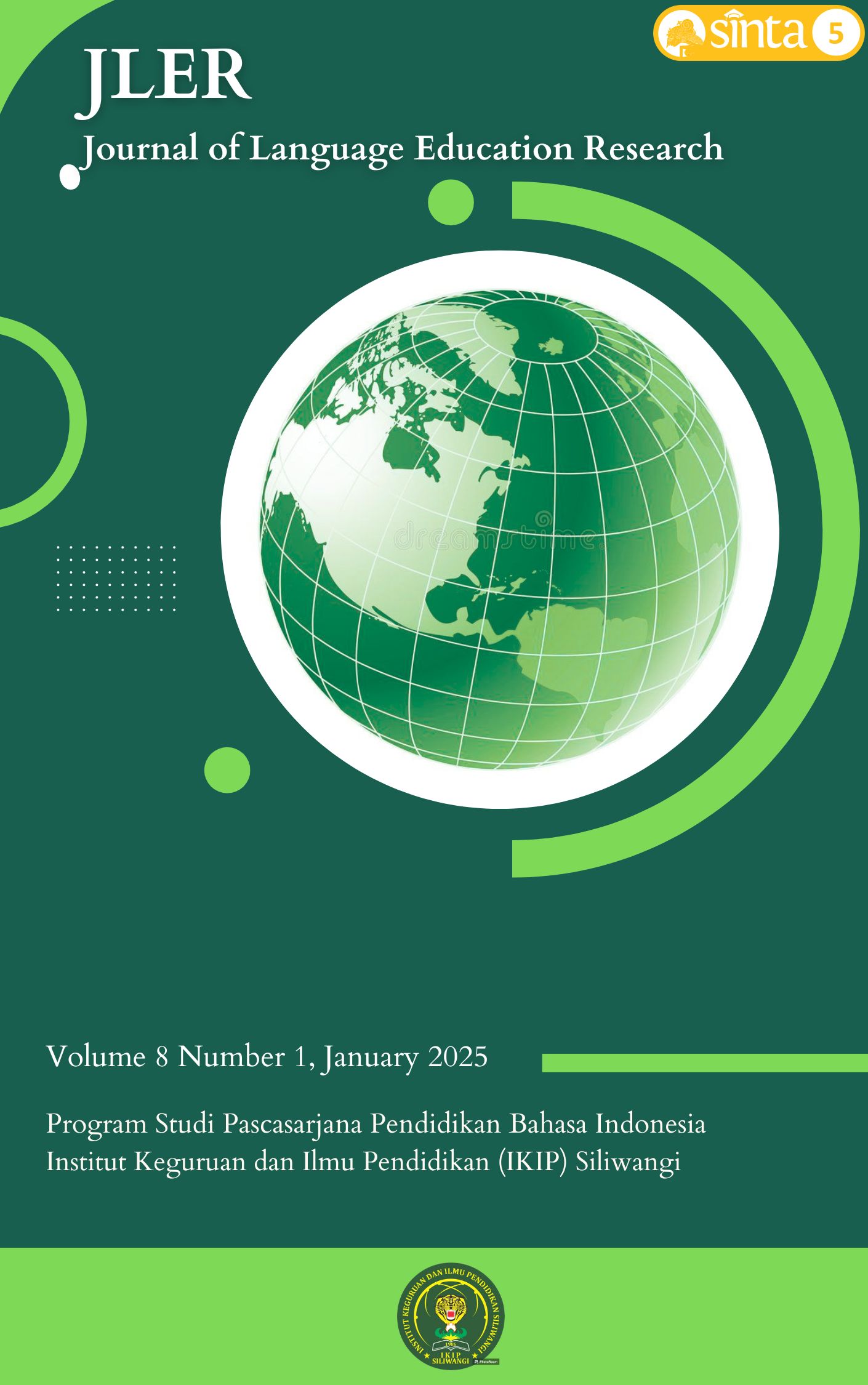The Facial Expressions Determine the Character of 5-Year-Old Children: A Study of Semiotics, Psychology, and Nonverbal Communication
DOI:
https://doi.org/10.22460/jler.v8i1.26609Keywords:
facial expressions, Child's character, 5 years old, semiotics, nonverbal communicationsAbstract
This study aims to examine the relationship between facial expressions and the character of five-year-old children through the perspectives of semiotics, psychology, and nonverbal communication. A child's facial expressions are considered important indicators in revealing their emotions and personality. Using a semiotic approach, this research analyzes the nonverbal signs present in the child's facial expressions, which can provide a deeper understanding of their nature and character. In the framework of psychology, facial expressions are seen as manifestations of emotional states related to the child's personality type, such as melancholic, sanguine, choleric, or phlegmatic. Additionally, the aspect of nonverbal communication in this study focuses on how children interact through facial expressions, indicating their level of concentration, assertiveness, or calmness. Based on the analysis of nonverbal signs, semiotic systems, and personality types, this study concludes that the child in the image shows characteristics of a choleric personality, with a determined facial expression, a defensive posture (arms crossed), and a focused gaze, suggesting dissatisfaction or resistance. Furthermore, other nonverbal signs also indicate sanguine traits with a cheerful expression and relaxed body, as well as melancholic traits with a serious expression and introspective tendency. The combination of these signs indicates that the child possesses a dominant, social, and sensitive character, with a tendency towards deep emotional feelings.
References
Anggreini, D., Eko Priyojadmiko, & Dwi Setiana. (2020). Analisis Koneksi Matematika Ditinjau dari Tipe Kepribadian Sanguinis, Koleris, Melankolis, dan Plegmatis. Buana Matematika : Jurnal Ilmiah Matematika dan Pendidikan Matematika, 10(1), 71–88. https://doi.org/10.36456/buanamatematika.v10i1.2406
Bambaeeroo, F., Shokrpour, N., . (2017). The impact of the teachers’ non-verbal communication on success in teaching. Journal of Advances in Medical Education & Professionalism, 5(2), 52.
Berry, D. S., & McArthur, L. Z. (1986). Perceiving Character in Faces. The Impact of Age-Related Craniofacial Changes on Social Perception. Psychological Bulletin, 100(1), 3–18. https://doi.org/10.1037/0033-2909.100.1.3
Cacoullos, R. T., & Travis, C. E. (2011). Testing convergence via code-switching: Priming and the structure of variable subject expression. International Journal of Bilingualism, 15(3), 241–267. https://doi.org/10.1177/1367006910371025
Carbon, C. C. (2020). Wearing Face Masks Strongly Confuses Counterparts in Reading Emotions. Frontiers in Psychology, 11(September), 1–8. https://doi.org/10.3389/fpsyg.2020.566886
Carvalho, C. A. S. (2024). Melancholy, trauma and therapy. Memory, Trauma and Narratives of the Self, 24–47. https://doi.org/10.4337/9781035337972.00007
Ekman, P. (1982). Methods for measuring facial action. In Handnook of Methods in Nonverbal Behavior Research (pp. 45–135).
Ekman, P. (1989). The argument and evidence about universals in facial expressions of emotion. In Handbook of social psychophysiology (Vol. 58, pp. 143–164). https://www.paulekman.com/wp-content/uploads/2013/07/The-Argument-And-Evidence-About-Universals-In-FacialExpressi.pdf
Ekman, P. (1999). Facial-Expressions_Ekman_1992.pdf (pp. 301–319).
Eze, C., R C Nurse, J., & Jassim, H. (2018). Kent Academic Repository. Computers in Human Behavior, 2, 197–206.
Gillett-Swan, J., & Sargeant, J. (2018). Assuring children’s human right to freedom of opinion and expression in education. International Journal of Speech-Language Pathology, 20(1), 120–127. https://doi.org/10.1080/17549507.2018.1385852
Hasanov, S. A., & Ernazarova, G. I. (2023). In The Poetry of Abduvali Qutbiddin Expression of Symbolism. International Journal of Social Sciences & Interdisciplinary Research, 12(01), 7–16. https://www.gejournal.net/index.php/IJSSIR
Hugenberg, K., & Bodenhausen, G. V. (2003). Facing Prejudice: Implicit Prejudice and the Perception of Facial Threat. Psychological Science, 14(6), 640–643. https://doi.org/10.1046/j.0956-7976.2003.psci_1478.x
Khan, T. N., Kauser, S., & Ahmed, A. (2023). CHOOSING A PROFESSION AS PER ONE ’ S PERSONALITY TRAITS AND CHOOSING A PROFESSION AS PER ONE ’ S PERSONALITY TRAITS. August. https://doi.org/10.20959/wjpr20222-21242
Ma, D. S., Correll, J., & Wittenbrink, B. (2015). The Chicago face database: A free stimulus set of faces and norming data. Behavior Research Methods, 47(4), 1122–1135. https://doi.org/10.3758/s13428-014-0532-5
Mahusay-Baria, R. (2015). The “Talker,” “Doer,” “Thinker,” and “Watcher”: Analysis of the Four Temperaments in Relation to Public Speaking Performances. Humanities and Social Sciences Review, 4(1), 121–126.
Mckelviet, S. J. (1973). The meaningfulness and meaning of schematic faces. Perception & Psychophysics, 14(2), 343–348. https://doi.org/10.3758/BF03212402
Mehrabian, A., & Ferris R. S. (1967). Inference of Attitudes From Nonverbal Communication in Two Channels. Journal of Consulting Psychology, 31(3), 248–252. https://doi.org/10.1037/h0024648
Muratova, A. N., Mazhitayeva, S., Sarybayeva, B. Z., Kelmaganbetova, A., & Kulibekova, Z. (2021). Non-verbal signs and secret communication as universal signs of intercultural communication. Rupkatha Journal on Interdisciplinary Studies in Humanities, 13(1), 1–10. https://doi.org/10.21659/RUPKATHA.V13N1.35
Murtinasari, F., & Lutfiyah, L. (2022). Pengaruh Tipe Kepribadian dan Karakter Siswa (Koleris, Plegmatis, Sanguinis dan Melankolis) Terhadap Pemahaman Konsep Bentuk Segiempat. Unisda Journal of Mathematics and Computer Science (UJMC), 8(2), 21–30. https://doi.org/10.52166/ujmc.v8i2.3553
Naim, M. (2017). Soft Skill Development: Relevance of Neuro-Linguistic Programming (NLP). Language in India, 17(2), 160–176. http://search.ebscohost.com/login.aspx?direct=true&db=ufh&AN=121725104&site=eds-live&scope=site
Putri, I. (2018). Komunikasi Non Verbal (Makna Kinesik) Pesulap Dalam Pertunjukan Sulap Klasik. Jurnal Ilmiah Syi’ar, 18(1), 56. https://doi.org/10.29300/syr.v18i1.1570
Rachman, T. (2021). Implementasi Kinesik, Proksemik, Paralinguistik Dan Self Disclosure Dalam Komunikasi Antarpribadi. Jurnal SEMIOTIKA, 15(2), 2579–8146. http://journal.ubm.ac.id/
Rosenberg, E. L., & Ekman, P. (1995). Conceptual and methodological issues in the judgment of facial expressions of emotion. Motivation and Emotion, 19(2), 111–138. https://doi.org/10.1007/BF02250566
Saleh, F., Rahman, F., & Hasyim, M. (2021). Metaphor in the Bugis Language Expression of the Sidenreng Dialectin South Sulawesi. International Journal of Arts and …, 4(1), 312–318. https://www.ijassjournal.com/2021/V4I1/4146575422.pdf
Salsabilla, C. A., Nasution, K. R. S., Siregar, Ad. H., Al-Hakim, M. F., & Efendi, E. (2024). Implementasi Bahasa Tubuh Terhadap Komunikasi Antar Budaya di Lingkungan Kampus (Studi Kasus Fakultas Ilmu Sosial Universitas Islam Negeri Sumatera Utara). INNOVATIVE: Journal Of Social Science Research, 4(1), 1640–1650. https://j-innovative.org/index.php/Innovative/article/view/8047
Downloads
Published
Issue
Section
License

This work is licensed under a Creative Commons Attribution-ShareAlike 4.0 International License.







